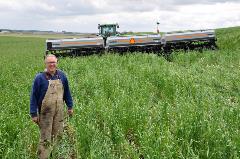Duane Hovorka, IWLA Agriculture Program Director
Outdoor America 2020 Issue 3
The new Congress convenes January 3, and high on its list of priorities should be finding solutions to two related problems: climate change and rebuilding the health of America’s soil.
A National Academy of Science study estimated that 10 percent or more of the excess carbon humans have emitted into the atmosphere in the past 12,000 years has come from the soil. That soil carbon was released due to plowing, over-grazing and soil erosion. Even today, the U.S. is losing topsoil far faster than it can be replaced.
Agriculture represents over 10 percent of U.S. greenhouse gas emissions including methane from livestock, nitrous oxides from fertilizer and tilled soils, and carbon dioxide from fuel used in farm machinery.
In the House of Representatives, one of the few farmers in Congress introduced comprehensive legislation in 2020 that would address both agriculture’s contribution to climate change and the need to restore the health of our soils.
Representative Chellie Pingree (D-ME) said her Agriculture Resilience Act “…is designed as a roadmap to sequester more carbon in the soil and reduce overall greenhouse gas emissions by supporting farmers where they are. We need to empower farmers with the best available science and provide a range of conservation tools, because what works for one farmer in Maine may not work for another in Iowa or Georgia.”
The bill includes two of the League’s soil health priorities: a good farmer discount on crop insurance, and a grant program to support state and tribal soil health efforts. The discount on federally subsidized crop insurance would reward farmers who adopt soil health practices that also make a major crop failure less likely. The grant program would help states and tribes implement soil health strategies that are adapted to their local soils, climate and farming systems.
A National Academy of Science study estimated that 10 percent or more of the excess carbon humans have emitted into the atmosphere in the past 12,000 years has come from the soil.
Increasing the organic matter in farmland soil by just one percent can put 10 tons of carbon per acre into the soil, while improving soil health and reducing the potential for polluted runoff from farm chemicals.
Rep. Pingree’s bill would increase funding for conservation easements that protect wetlands and native prairie, helping maintain the large amounts of carbon stored in wetland and prairie soil. It would boost investments in solar, wind and other renewable energy systems on farms and ranches.
The bill would also provide support for pasture-based livestock systems and increase funding for on-farm research in climate-friendly farming techniques. With support from many farm and conservation organizations, Rep. Pingree’s bill could provide a starting point for Congressional action in 2021.
Millions of Jobs
The Senate Democrats’ Special Committee on the Climate Crisis released its own report in August that outlines a path to a clean economy that it says “… will make our economy stronger, drive innovation, and create millions of new [jobs] that cannot be outsourced overseas.”
The report’s recommendations include expanding existing Farm Bill conservation programs, and providing improved incentives and more technical assistance to help farmers and ranchers adopt soil health practices and install solar, wind, geothermal and other renewable energy systems on farms and ranches.
 Iowa farmer Steve Berger in a field of cereal rye cover crops, which, between growing seasons, increase carbon in the soil and protect it from erosion.
Iowa farmer Steve Berger in a field of cereal rye cover crops, which, between growing seasons, increase carbon in the soil and protect it from erosion.
“The longer we fail to act, the more costly climate change will be,” said Senator Tammy Baldwin (D-WI). “Our agricultural economy has a lot to lose if we don’t act on climate change. That is why we need to support the innovative practices that farmers are already doing to be part of the solution and generate new economic growth for rural communities.”
Additional funding would support research, development and deployment of advanced biofuels and the development of low-cost methods to measure carbon in the soil.
The U.S. Department of Agriculture (USDA) offered its own agenda for reducing the climate impacts of agriculture in the coming decades. USDA’s Agriculture Innovation Agenda identified research, program changes and other actions it says “…will stimulate innovation so that American agriculture can achieve the goal of increasing U.S. agricultural production by 40 percent while cutting the environmental footprint of U.S. agriculture in half by 2050.”
Reducing agriculture’s climate impact is laudable but the research agenda USDA proposed largely ignored the need for soil health research, as the League pointed out in comments provided to USDA in July. The League also asked USDA to put soil health at the center of its conservation program delivery to farmers.
A national initiative to educate farmers and ranchers about healthy soils and support soil health planning, testing and better management practices would provide huge benefits in restoring America’s soils, addressing climate change and providing vast economic benefits to farmers and ranchers.
Despite their differences, the three approaches all reflect a growing bipartisan consensus that American agriculture can and must find ways to address climate change and reduce its carbon footprint.
Learn more about sustainable agriculture